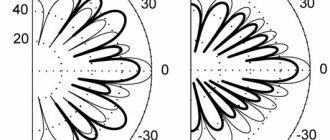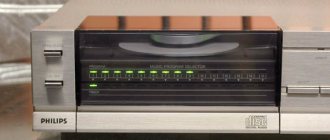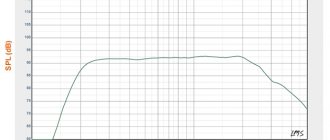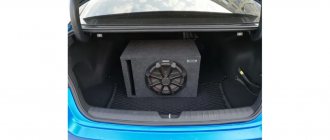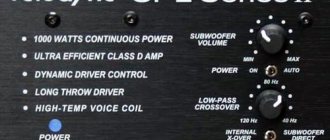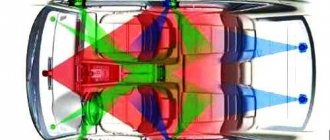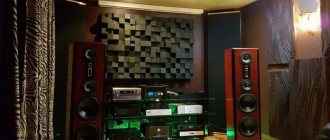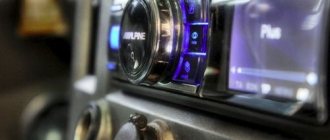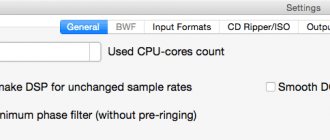20 October 2022, Sun
There is no music lover who has not thought about purchasing a subwoofer at least once in his life. Just as there is no sound engineer who could imagine a concert without acoustics of this type. After reading our publication, you will learn some useful facts about subwoofers: design features, installation rules, nuances of setting them up and much more. The purpose of this article is to provide basic information about this type of speaker system.
Electro-Voice TX2181
Literally, the word “subwoofer” means “ultra low-frequency speaker.” This term is used to describe any speaker system that has a low-frequency driver in its design. In other words, a “subwoofer” is a loudspeaker that reproduces the lowest sounds that standard wideband acoustics are not capable of transmitting.
Electro-Voice EVC-1181S-W
Where and what is a subwoofer used for?
For the most part, phonograms of modern music have a pronounced sound in the low-frequency spectrum; this spectrum of music is most important for transmitting musical energy and drive. It is for this reason that a subwoofer is required for high-quality reproduction of modern professional recordings. In addition to the stage, this type of acoustics has also found its application in nightclubs, home theaters, and cars.
It should also be noted that high-quality acoustic systems reproduce sound over the entire frequency range and are not capable of sounding only the lowest frequency range. This is what subwoofers are used for. Nowadays, a subwoofer is often used as a mid-bass component of a system, which is not entirely true. After all, Sub Bass is more of an addition to your audio system. The subwoofer only gives the low-frequency sound the necessary volume and velvety, like the salt and spices that we add when preparing food.
RCF S8018
AND REALLY, WHY?
The question is partly sacrilegious, but let us remember: the most avid audiophiles (and those who simply like to listen to music who have joined them) can easily get by at home with speakers with low-frequency speakers of the caliber (using our terminology) of the same 6 - 7 inches that we have at the front, and feel great. By and large, there are two main reasons; it is not difficult to recall them again.
First: car doors are not at all equivalent to the powerful housings of home speakers, no matter what you do with them, and at the lowest frequencies the sound pressure drops. The midbass diffuser (if its frequency band is not forcibly limited in any way) desperately shakes, trying to portray bass, but they die in leaks and the softness of the thin steel shell, and only distortion becomes an audible result. They, as befits harmonics, are higher in frequency, therefore they are reproduced perfectly.
Second: in the car, music is listened to at higher volume levels, especially at low frequencies. This is due to both the incomparably higher level of external noise and simply tradition, which can outweigh any physical laws. How much do motorists like bass? In general, we know the answer: they love it very much. More precisely, in decibels?
Design features of subwoofers
The hearing of a young healthy person is capable of detecting sounds in the range from 20 Hz to 20 kHz. With age, the boundaries of this range narrow, and a person begins to hear a little worse, precisely in the high-frequency range. This is due to the fact that, unlike low sounds, high ones have a shorter sound wave and low self-energy, for the same reason it is much easier to reproduce high frequencies than low ones. Nowadays, mid-frequency and high-frequency acoustics are structurally close to their perfection. To reproduce the frequency range from 20 to 400 Hz by a low-frequency emitter, a larger and more massive diffuser is required, which, in addition, must have high mechanical rigidity, ensuring resistance to bending. The use of large diameter diffusers increases the resistance and compressibility of air. A design feature of the woofers is the use of a powerful inductor, which significantly increases the weight of the structure.
Due to the high power input to the woofer, heat must be removed quickly and efficiently from the voice coil and amplifier. A power source needs to be powerful and of high quality, which in turn affects the cost. Until now, problems associated with resonances arising from the superposition of reflected and direct waves remain unsolved. The reason for the appearance of interference is the long LF wavelength, comparable to the size of the room and the acoustic body itself.
To avoid these problems, low-frequency acoustics are often placed in a separate housing. Structurally, an active subwoofer is very simple: a cubic body, a low-frequency head and an amplifier capable of reproducing sound in the frequency range 20 - 500 Hz.
Having studied the design of a subwoofer, you can come to one important truth: the larger the speaker, the more spacious and powerful the bass. Due to the fact that the diffuser located inside the subwoofer housing has a fairly large diameter, low-frequency acoustics always have large dimensions.
Types of subwoofers by type of amplification
All subwoofers can be divided into two types according to the type of amplification: active and passive. The first ones are equipped with a power amplifier and a special filter that cuts off sound outside the operating range. Passive subwoofers consist of a housing and a speaker. They require an external amplifier.
dB Technologies SUB 15D
Characteristics
- The frequency range, measured in hertz, is one of the most important characteristics of a subwoofer. For convenience, this range is divided into several octaves:
- Lowest bass 20-40 Hz,
- Mid bass 40-80 Hz,
- High bass 80-160 Hz.
Even the most budget models reproduce the range from 40 to 200 Hz. And only top-end acoustic models can reproduce frequencies from 20 Hz.
- The crossover frequency is the upper range of the subwoofer and it is also the lower range of the mid-low frequency emitter.
- SPL (Maximum Sound Pressure Level) – Maximum Pressure Level is the peak pressure that the subwoofer is capable of providing.
- Speaker sensitivity (dB) – speakers with higher sensitivity load the amplifier less and are able to produce higher sound pressure.
- Woofer diameter.
Comparing models
The main characteristics of the considered subwoofers in one place.
| Model | Reproducible frequencies, Hz | Power, W | Emitter diameter, mm | Dimensions, mm | Weight, kg | Price, rubles |
| YAMAHA YST- SW012 | 28-200 | 100 | 200 | 290x290x328 | 8,5 | 7990 |
| YAMAHA YST- FSW050 | 35-160 | 100 | 165 | 349x175x349 | 8,45 | 9990 |
| YAMAHA YST-SW216 | 20-160 | 270 | 250 | 350x430x382 | 19 | 24 990 |
| YAMAHA YST- SW215 | 28-200 | 150 | 200 | 290x360x322 | 11,5 | 16 490 |
| PIONEER S-51W | 26-900 | 150 | 200 | 360x382x360 | 13,5 | 18 390 |
| VELODYNE IMPACT-10 | 29-140 | 275 | 250 | 366x391x455 | 13 | 29 990 |
| JAMO SUB 210 | 38-200 | 200 | 203.2 | 283x313x305 | 7,5 | 25 990 |
| JBL STUDIO SUB 260P | 29-150 | 600 | 305 | 381x445x435 | 17,2 | 37 910 |
| BOWERS & WILKINS ASW608 | 32-140 | 200 | 200 | 260x260x330 | 8,85 | 39 490 |
Types of sub-bass acoustic design
The design features of the subwoofer housing significantly affect its acoustic properties. The acoustic design of the subwoofer bass head is divided into the following main types:
- Closed,
- With bass reflex,
- With bandpass filter.
HH Electronic VRS-118A
Closed-box subwoofers have the simplest and most efficient design. The advantages of the design include:
- No air leakage to the outside and therefore no sound,
- Deep bass
- Smooth amplitude-frequency response,
- Low distortion.
The disadvantages of closed box subwoofers include:
- Low coefficient of efficiency (efficiency),
- Large weight and dimensions.
Park Audio SW128 MkII
Bass reflex type subwoofers have a special hole in the housing through which some of the air escapes. A tube of a certain length is often inserted into this hole. Sometimes there are several of them. Selecting the length of the tube allows you to set the correct resonant frequency of the bass reflex. Sometimes the bass reflex port is made in the form of a slot. This makes the case more compact. This type of bass reflex is often used in studio monitors. In the process of amplifying low frequencies, an important role is played by acoustic resonance and its main frequency, at which notes sound much louder than others. Correctly setting the resonant frequency of the bass reflex allows you to obtain greater speaker efficiency and beautiful, velvety bass. Very often the resonant frequency is determined incorrectly, which causes many problems. To avoid errors when calculating, they are guided by the following rule: “The resonance frequency of the bass reflex must be no more than 33% lower than the resonance of the speaker in the same housing with a closed bass reflex.”
Advantages of subwoofers with bass reflex:
- Thanks to the large stroke, the diffuser can be small in size and provide a fairly low sound,
- High sound pressure,
- High efficiency.
Flaws:
- To set it up correctly, you need to have knowledge in electroacoustics and be able to adjust the delays between the mid-high frequency path and the sub bass,
- This design introduces a large amount of distortion into the sound.
RCF SUB705AS
A subwoofer with a bandpass filter (often this design is called a bandpass) has features of both a bass reflex and a closed enclosure, thereby inheriting their advantages and disadvantages. Its box is divided by a partition into two even parts, one of which has a bass reflex, the second is a closed volume. This design allows you to increase the sound pressure level, but at the same time reduces the range of reproduced frequencies. Subwoofers of this type are very compact and are successfully used in enclosed spaces.
Loudspeaker housing with tunnel type acoustic design. (Incision)
The rarest type of subwoofer acoustic design is the “labyrinth” ; its operation is based on acoustic resonances. Acoustics with this type of design are difficult to produce; finished products are much more expensive than their analogues.
Advantages of subwoofers with acoustic design “Labyrinth”:
- The efficiency is higher than that of the closed type, but equal to the bass reflex type,
- Minimum amount of introduced distortion (compared to a bass reflex)
Flaws:
- High price,
- Difficulty setting up
Housing with passive radiator inside
A passive radiator subwoofer (also referred to as PAS) is a fairly new type of acoustic design that uses an unconnected additional speaker as a passive resonator. Thus, having only one amplification channel, you get twice the radiation area, thanks to the total area of \u200b\u200bthe two diffusers.
Advantages of subwoofers with passive radiator:
- Smaller dimensions compared to the closed type,
- No extraneous or resonant sounds.
Flaws:
- Large power loss
- Low speaker sensitivity,
- A massive passive radiator negatively affects the transmission characteristics.
TOP 3 subwoofers for rooms from 30 sq. m
In large rooms, the following subwoofers are clear favorites.
JAMO SUB 210
Available in different colors: black, wood, white, dark wood. Manufactured in a classic design with a long-throw driver for low-frequency reproduction. The model is characterized by clear and rich bass, for which the amplifier is responsible. The power at moments of maximum load can reach 200 W. The sound is produced by a 203 mm bass reflex driver, directed downward. The solution helps to increase sound pressure and ensure proper distribution of audio in all directions.
| Characteristic | Meaning |
| Frequency range | 38-200 Hz |
| Power | 200 W |
| Speaker diameter | 203.2 mm |
| Dimensions | 283x313x305 mm |
| Weight | 7.5 kg |
Pros:
- small size and light weight;
- assortment of colors;
- voluminous, bright bass without distortion.
Minuses:
- excessively bright LED;
- Smooth adjustment knobs impair sensitivity.
Price: 25,990 rubles.
JBL STUDIO SUB 260P
The bass reflex subwoofer from the USA is characterized by high functionality and a power of 300 W. Peak values can reach 600 W. Despite the simple design, the model remains stylish thanks to the black color of the wood and plastic inserts. To prevent plastic elements from degrading the sound, they are treated with insulating materials. The active subwoofer covers the range of 32-150 Hz, that is, this includes almost the entire low-frequency spectrum.
| Characteristic | Meaning |
| Frequency range | 29-150 Hz |
| Power | 600 W |
| Speaker diameter | 305 mm |
| Dimensions | 381x445x435 mm |
| Weight | 17.2 kg |
Pros:
- huge power, suitable for full-fledged cinemas;
- there is a system for manual adjustment of parameters;
- high-quality and clear sound throughout the entire low-frequency range.
Minuses:
- there is no remote control;
- The controls are located on the rear panel, making them difficult to use.
Price: 37,910 rubles.
BOWERS&WILKINS ASW608
The junior model of the well-known series of subwoofers has a number of unique properties. This includes an unusual design based on Kevlar, paper and special resins. The material is characterized by high strength and mobility. The 20 cm speaker with an easily bending diaphragm produces rich and deep bass. There is no need for a separate amplifier, because the built-in device can output 200 W. The bass extension and equalization system is adjustable using toggle switches on the back cover of the subwoofer.
| Characteristic | Meaning |
| Frequency range | 32-140 Hz |
| Power | 200 W |
| Speaker diameter | 200 mm |
| Dimensions | 260x260x330 mm |
| Weight | 8.85 kg |
Pros:
- dynamic and deep bass;
- supports many connection methods;
- allows you to adjust the cutoff frequency and volume;
- automatic sleep mode.
Minuses:
- no remote control;
- The power LED is too bright.
Price: 39,490 rubles.
How to position the subwoofer correctly?
Typically, subwoofers are installed on the floor, in front of or below the stage, directly below or behind the PA system. There are models of suspended subwoofers that are attached to a mounting frame, allowing you to assemble clusters of low-frequency and full-range cabinets and providing an even sound field. Sometimes it makes sense to place all the LF cabinets in the center as a mono cluster, other times they are placed to the left and right of the stage, directly below the full-range cabinets.
In recent years, the method of cardioid arrangement of subwoofers has become widespread. It is based on a precisely calculated relative position of sub-bass and will allow you to control the total directivity of an array of subwoofers, changing the signal levels of certain groups of array elements. This makes it possible to eliminate the comb filter effect (simply put, to ensure uniform bass without pressure drops) and direct the sub-bass energy only forward, or forward and to the sides, depending on the geometry of the sounded space. The same technology makes it possible to almost completely remove the sound coming from the sub-bass back, which ensures maximum transfer of sound energy forward and obtains almost silence on stage. In other words, the sound from the sub bass does not disturb the performer on stage.
Cardioid subwoofer arrangement
One of the main problems associated with the use of subwoofers is the incorrectly calculated signal delay between the full-range speakers and the sub-bass. To the ear, this is felt as a blurred sound in the midrange and low impact in the lows. Simply put, you need the sound of the sub-bass and the full-range system to reach the listener at exactly the same time.
The easiest way to achieve this is to move the subwoofer back and forth relative to the full-range cabinet, and thus find the place where you get the most bass response and intelligible sound. To more accurately adjust the delay, it is better to use an acoustic processor and special software that allows you to use a microphone to accurately determine the phases of signals from different sound sources and correct them correctly.
Types of mutual arrangement of subwoofers and wideband acoustics
Arranging subwoofers in the form of a mono cluster allows you to significantly reduce their number. The disadvantages of this method include:
- Trimming the bottom of the acoustic space to increase the sound coverage area increases the sound pressure in the front rows.
- The difference in sound pressure between the first and last rows can reach 26 dB.
Reciprocal arrangement of subwoofers and line array
Useful tips
In conclusion, here are a few so-called life hacks for using a subwoofer. The first is that the resonances (and therefore problems with the frequency response of the audio system) of a typical living room lie precisely in the low frequency region, where the subwoofer works - 20-150 Hz. Therefore, having previously found the best location for the main pair of speaker systems (whether bookshelf or floor-standing) in terms of their sound, as well as aesthetics and convenience, you can more easily cope with the resonances of the listening room by moving and finding the ideal location for the subwoofer in it. As we have already said, low frequencies are distinguished by extremely low directionality of sound, so if you have several midrange/high-frequency speakers in the system, you can often get by with just one subwoofer. However, in fairly spacious rooms, to obtain uniform bass with a minimum of distortion, the best results can be achieved by using two subwoofers at once. In this case, you can use two identical models, or completely different ones, for example, one compact and maximum “fast-firing”, and the second with a large speaker (from 12” and above) to give the bass depth and “velvety”.
Another problem in reproducing high-quality soundtracks is that many of them are recorded with bass cut below 50 Hz (so that they can be reproduced without significant distortion on mass budget equipment), while others, on the contrary, are recorded with excess bass (for commercial promotion purposes). specific release). Modern high-quality amplifiers, as a rule, are not equipped with a loudness compensation mode, therefore, in “trifonic” systems, having, in fact, separate amplification and adjustment of low and all other frequencies, you can easily and quickly adjust the amount and depth of bass - if necessary, almost for each track or album (a subwoofer with a remote control or controlled by a tablet or smartphone is best suited for this). The same bass adjustments will be very useful if you want to listen to music late in the evening, when neighbors or family members are already resting - this can be done at a completely comfortable volume, simply by “tapering” the bass on the subwoofer.
So, we have figured out in general terms what a subwoofer is and why it is needed. This article provides only the basics of using this component of a home audio system, and in order for it to fit perfectly into your sound environment, we recommend contacting the specialists of Audiomania, who will take into account all the nuances of your home and offer the best solution.
This article has been read 65,676 times.
The article is included in the sections:
How to choose. Buyer's Guide
Application of subwoofers with line arrays
Between subwoofers and line arrays there is a delay in a small frequency range in the overall spectrum near the crossover frequency. In order to eliminate the delay, you need to compensate for the time delay, thereby synchronizing them. But synchronization does not solve this problem, since the delay in the front and back rows can differ significantly.
Based on physical laws, it would be logical to place subwoofers at the same height as line arrays. Thus, we will be able to eliminate delays, level out the frequency response and remove frequency distortions, but in return we will have to sacrifice the efficiency of the subwoofers. This compromise allows you to obtain a homogeneous sound picture in the crossover cutoff frequency region.
Electro-Voice XLC118
How to choose a subwoofer?
We have prepared a few simple rules for you, following which you can choose a good subwoofer:
- More expensive – more often means better. Don’t try to save money, because the investment will pay off with high-quality sound and years of operation.
- Buy a subwoofer with a little more power to have some reserve. This will allow you to use your sound system at 50-60% power and get high-quality sound without distortion.
- Always choose a subwoofer gain with a good headroom. Remember: the speaker coil is more likely to burn out when working with a weak amplifier. As a result of overloading a weak amplifier, a huge amount of signal distortion appears at its output, and its DC component can easily damage the coil of your diffuser. On the contrary: a higher power amplifier will only make the diffuser move more intensely without causing harm to it. Numerous tests prove the correctness of this postulate. You can check its accuracy by carefully studying the characteristics of active subwoofer models. Sometimes the power of the amplifier can be 2-2.5 times higher than the power of the speaker.
- Not everything depends on your wideband speakers. The more powerful the subwoofer, the more area it can fill with sound. In addition, the subwoofer has more energy than the midrange + bass cabinet.
- The narrower the subwoofer's operating range, the more efficiently you will use the amplifier's power and get high-quality bass. Although, in some cases it is necessary to “open” the upper range of the sub more, thereby providing better attack in the mid-bass spectrum.
- It is highly desirable that the subwoofer have the following controls: Level, Frequence and Phase. This will allow you to customize it easily and simply.
Electro-Voice QRX118S
